

Gower's
Walk Free Schools
The area became the setting for an industrial / technical / vocational educational experiment which in its day was successful and much-admired. In the early 19th century, the lane lay within the parish of St Mary Matfelon, the medieval 'white chapel' which gave its name to the district. Rebuilt in 1875, and again after a fire in 1880, it was bombed in 1940; the site was cleared in 1952 and is now Altab Ali Park, commemorating a Muslim martyr, but in the process (as one commentator puts it) airbrushing the ancient parish church out of history. Gower's Walk became part of St Mark's parish when this was created in 1839, then of St Paul Dock Street when St Mark's was closed, and finally of the present-day parish of St George-in-the-East with St Paul.
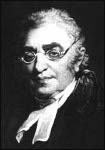 Dr
Andrew Bell (1753-1832) [right], a Scot who after a
spell in the USA became
an Anglican clergyman, went as chaplain to the East India Company and
ran the Madras Male Orphans' Asylum, educating solders' children.
Short of teachers, he used the older pupils to instruct the younger
ones, and the 'Madras system' of 'mutual instruction' was born. On
his return to England, he published in 1799 An
Analysis of the Experiment in
Education. St Botolph's School in Aldgate was the first
institution to adopt his method. It was adapted by the Quaker
Joseph
Lancaster into what became known as the 'monitorial system',
and provoked much debate. Bell
responded to his critics with an 1808 pamphlet Sketch of a
National Institution, urging the Church of England to adopt
his
system in their schools, and in 1811 became one of the founders of
the 'National Society for Promoting the Education of
the Poor in the Principles of the Established Church', which
established thousands of schools throughout England and Wales. The
National Society (which now
shares staff with the Church of England
Education Division) celebrated its bicentenary in 2011: see Lois Louden Distinctive and Inclusive: The National Society and Church of England Schools 1811-2011 (National Society 2012). For more on the NS and Lancasterian schools
see here.
Dr
Andrew Bell (1753-1832) [right], a Scot who after a
spell in the USA became
an Anglican clergyman, went as chaplain to the East India Company and
ran the Madras Male Orphans' Asylum, educating solders' children.
Short of teachers, he used the older pupils to instruct the younger
ones, and the 'Madras system' of 'mutual instruction' was born. On
his return to England, he published in 1799 An
Analysis of the Experiment in
Education. St Botolph's School in Aldgate was the first
institution to adopt his method. It was adapted by the Quaker
Joseph
Lancaster into what became known as the 'monitorial system',
and provoked much debate. Bell
responded to his critics with an 1808 pamphlet Sketch of a
National Institution, urging the Church of England to adopt
his
system in their schools, and in 1811 became one of the founders of
the 'National Society for Promoting the Education of
the Poor in the Principles of the Established Church', which
established thousands of schools throughout England and Wales. The
National Society (which now
shares staff with the Church of England
Education Division) celebrated its bicentenary in 2011: see Lois Louden Distinctive and Inclusive: The National Society and Church of England Schools 1811-2011 (National Society 2012). For more on the NS and Lancasterian schools
see here.
An
admirer, and colleague in founding the NS (together with his friend
and neighbour William Cotton), was William
Davis
(1767-1854), of Goodman's Fields. He served on the committee of the
NS until his death. According to Charles Crouch Hall (Society of
Genealogists MX/M69, 1917), there was a marble tablet to him in the
porch of the now-lost church of St Mary Matfelon:
|
William
Davis, late of Whitechapel, of Leytonstone Essex, and Brockhampton*
Gloucestershire, died 19 November 1854 aged 87
Argent: a chevron pean in base a lion rampant .... on a chief indented sable a canton ermine Crest: A demi-lion issuant charged with the Roman fasces between the paws a bomb fired .... |
*
Hall says this is a mistake for Brockworth; both are villages in
Gloucestershire.
 Davis
was concerned about the education of the poor
around his sugar works in Whitechapel,
and had housed and provided
a schoolmistress
for some of them in the vicinity. He met Bell in 1805 and persuaded
his fellow-trustees at Whitechapel Foundation
School to trial Bell's
methods. Encouraged by the results, he founded his own school in
Gower's Walk, providing a plot of land, formerly a sugar bakehouse,
and built premises large enough to accommodate 300 children,
together with apartments for a master and mistress; he endowed it with
£2,000 3% Consols. It was opened
without show on 4 January 1808, in the presence of Davis and his wife
(who was to be actively involved in its work), one friend, the
schoolmaster and mistress, the first intake of children and the local
curate, who dedicated the buildings. It was to be widely-visited by
bishops and others as a model for the nascent National Society,
although it was not intially a NS school as such. William
Lovell was one of the early masters.
Davis
was concerned about the education of the poor
around his sugar works in Whitechapel,
and had housed and provided
a schoolmistress
for some of them in the vicinity. He met Bell in 1805 and persuaded
his fellow-trustees at Whitechapel Foundation
School to trial Bell's
methods. Encouraged by the results, he founded his own school in
Gower's Walk, providing a plot of land, formerly a sugar bakehouse,
and built premises large enough to accommodate 300 children,
together with apartments for a master and mistress; he endowed it with
£2,000 3% Consols. It was opened
without show on 4 January 1808, in the presence of Davis and his wife
(who was to be actively involved in its work), one friend, the
schoolmaster and mistress, the first intake of children and the local
curate, who dedicated the buildings. It was to be widely-visited by
bishops and others as a model for the nascent National Society,
although it was not intially a NS school as such. William
Lovell was one of the early masters.
What
marked out Davis' school was his determined incorporation of the
'industrial principle' -
combining education with learning a trade.
Over the door were the words
| FOR TRAINING UP CHILDREN IN THE PRINCIPLES OF THE CHRISTIAN RELIGION, AND IN HABITS OF USEFUL INDUSTRY |
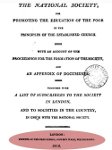

 For
boys, this was printing, and for girls needlework. (At Whitechapel,
the boys had been engaged in toy-making.) There had been a few other
previous schools - including a Lancasterian school in Borough Road
Southwark - with printing presses, but the enterprise here was more
thoroughgoing. A large number of well-produced sermons, pamphlets and
reports came off the presses. Many of the early documents
and
reports of the National Society were printed 'at the Free-School,
Gower's-Walk, Whitechapel' [ellipse
colour added], and there were also complex technical documents for the London Hospital.
For
boys, this was printing, and for girls needlework. (At Whitechapel,
the boys had been engaged in toy-making.) There had been a few other
previous schools - including a Lancasterian school in Borough Road
Southwark - with printing presses, but the enterprise here was more
thoroughgoing. A large number of well-produced sermons, pamphlets and
reports came off the presses. Many of the early documents
and
reports of the National Society were printed 'at the Free-School,
Gower's-Walk, Whitechapel' [ellipse
colour added], and there were also complex technical documents for the London Hospital.
| Complete
success has attended Mr. Davis's experiment. The children, at this
present time, are 110 boys, and 50 girls. The boys are taught all
that ought to be taught in charity-schools - reading, writing, and
the rudiments of arithmetic; the girls are taught sewing, knitting,
and marking; they spell, read, &c. with the greatest precision
and facility. Many ladies and gentlemen who have visited the school,
have expressed their surprize at the perfection to which the children
have arrived in reading and spelling. Educated in this mode they
learn all that a charity-school purports to teach, in half the time,
and with tenfold greater correctness than by the old methods, and
this allows opportunity for the acquirement of industrious habits.
There is a printing-press of the latest (Lord Stanhope's)
improvement, in a workshop, which gives employment to the boys; and
the girls are busied in all
sorts of useful needle-work and knitting.
But the privilege of working the press (which gives the hand of a boy
the power of fifteen horses, by a curious combination of levers), and
of taking up the needle, must be obtained as an indulgence, by
previously performing their tasks in school in a perfect manner. The
children receive a share of what they earn, and have some rewards
beside. At how small an expence, a school of this sort may be
supported is inconceivable. The "Gower's Walk School",
exclusive of the dividend on £2000 3 per
cents, supports itself.
We
have been favoured with an account of payments and receipts for the
last year, from the second Report of the school just published; —
and we feel great pleasure in this opportunity of making it public.
We
understand that the school doors are always open to the visits of any
respectable persons. — But the examination of the children's
proficiency takes place on Thursdays at two o'clock; at which time
the nature of the establishment may he studied, with the least
possible interruption to the business of the place. We are satisfied
that vast improvements may be derived to ordinary charity-schools, by
adopting the plans pursued in the "Gower's Walk Free-School";
to the management of which we respectfully solicit the attention of
the trustees and governors of our parochial schools. |
||||||||||||||||||||||||||||||||||||||||||||||||||||||||||||||||||||||||||||||||||||||||||||||||||||||||||||||||||||||||||||||||||||||||||||
| Many excellent persons have objected to ‘dispensing to the children of the poor such knowledge as would tend to raise them above their station, (such, for instance, as writing and cyphering [arithmetic])––and , in truth, if it was unaccompanied by the checks of an early religious education, their apprehensions might be just; but let it be remembered, that this school was founded for the sole purpose of teaching poor children to read and understand their Bible; writing, arithmetic, and works of industry have been added as useful appendages. |
| To all those who take an interest in Institutions of this nature, and
particularly to those Friends who patronise it, by giving employment to
the Children, an account of its state and progress is due and may be
acceptable; and it is not doubted but that they will be gratified to
learn, that the School is fulfilling all that has been anticipated. The Managers have to report, that Mr. DEANA has been appointed Master of the Boys' School; he has for near twelve months conducted the department of instruction to their perfect satisfaction, and co-operates most zealously with Mr. JOHN FRENCH, who superintends the printing: under their able, steady, and mild conduct, it is confidently presumed, that the Boys will still preserve those unassuming and industrious habits, which with scarcely an exception, have characterized those who have quitted the School. The unceasing vigilance and anxiety of Mrs. LOVELL for the welfare of the Girls' School, continue to be exerted, almost, it is to be feared beyond her strength; but a deep sense of the duties she has undertaken, and a recollection of the considerable numbers she has trained in habits of virtue and industry, will not allow her to relax: and here it may not be improper to point out the great difference between a Boys' and a Girls' School; and, in giving a statement of accounts, how unlikely it is that the comparison should be favourable to the latter. What unceasing labour and attention for a small account of profit!
Here, however, you may find the test of patience and perseverance, and amply will SHE be paid, who possesses these virtues. For every child will be to her a reward,— in all relations of life their value will ultimately be found, who, having beep trained under such mistresses, are qualified for every department of female industry, and, at the same time, have acquired a perfect knowledge of their Christian duty, and the usual attainments of reading, &c. Every possible encouragement is given, in rewards, in clothing and money, to the senior good and industrious Children (Boys and Girls) to remain in the School until they are 14: long experience having convinced the Managers of the importance of forming the character—this cannot well be done much sooner than at this period of life, and to retain them longer is not desirable.
The numbers on the Books now are 150 Boys, 150 Girls, of whom about 130 of each sex are in daily attendance.
The Saving Bank continues a very valuable appendage to the Institution, many young persons who have left the School, availing themselves of its advantages. The amount in Debentures is now £300. |
||||||||||||||||||||||||
| The
managers of the National Free-school, Gower's Walk, Whitechapel,
express their opinion that children should not be sent to their school
till seven or eight years of age;—in that opinion we concur. Before
that age they only obstruct the regular business of the school, without
deriving much benefit themselves; for the engagements of the master
prevent him paying sufficient attention to them. They, in fact, require
the superintendence afforded in an Infant School. The managers also
think that a child should not leave school till 14; here too we agree
with them: we will give their reason in their own words.—They consider
the foundation of every public school ought to be religious, and
whatever learning may be given, or works of industry superadded, they
all should be made subservient to inculcating the moral and religious
principle. The managers feel a conviction that this is most effectually
done in the two or three last years of attendance; and therefore they
use every worldly device, as well as exhortation, to induce the parents
to keep their children here till 14, when they must either go out as
apprentices or servants. We strongly recommend the following practical observations to the consideration of the conductors of National Schools. The system of teaching is purely Madras. The works of industry, whether carried on by boys or girls, are found to be agreeable to the children, as volunteers are always on the alert to be employed; they like work better than reading, therefore they are never allowed to go to work unless the lesson has been well said. One of the important instruments of discipline is the fund-book, where, as soon as a boy (or girl) realizes two pence, at the end of the month one penny is placed to his credit, and the other is given to him. With the skill of the children the rewards increase, and it frequently happens, that for the last year a boy will earn four shillings a month; two will be placed to his credit, and two he will take home; the accumulated amount is given when he quits the school: a boy frequently takes from three to five pounds, and a girl from two to three. It is scarcely necessary to say, that the whole or any part of this fund may be forfeited by bad behaviour, and the children are not entitled to any if they quit the school before they are fourteen. Another means of reward is by clothing. The scholars begin to receive some trifling article of clothing about the age of ten or eleven. The first year, perhaps shoes or stockings, or both; the next, a gown or jacket; the third or last, the boys receive a suit, and the girls, gowns and bonnets. To the foregoing are added, at the annual examination, as prizes for proficiency and good conduct, bibles, prayer-books, and a few small silver medals. As an inducement to those who had quitted the school to continue the plan of saving, which, in some degree had commenced with the fund-book, a provident bank was established in the year 1817. An annual meeting is held in the school-room the first Monday afternoon in June; many of the old scholars meet, and reciprocal congratulations prove the value of the education they have received. The deposits of the bank now amount to about 900l." |
Ten
years later came this report from Frederic Hill, in a 2-volume work
National
Education: Its Present State and Prospects (1836).
His words about the 'little printers' and their enthusiasm for working
on holidays appear condescending,
and we may disagree with his conclusion about whether they were
being exploited. But they show that the school was popular, and the
quality of its printing
work was unquestionable. In 1838 it had 112 male and 78 female pupils.
|
GOWER'S
WALK SCHOOL OF INDUSTRY The industrial occupation of the boys is printing; that of the girls needlework. There are altogether about two hundred children in the school, rather more than one half of whom are boys. Both boys and girls are in attendance during seven hours each day. Four hours of this time are given to the usual business of a school,—namely, reading, writing, and arithmetic; the remaining three hours are employed by the girls in needlework, and the boys in printing; with this restriction, however, that no boy is allowed to join the class of printers (a privilege much coveted) until he can read, write, and cipher, with a certain degree of facility. This regulation is found to act very beneficially in furnishing a motive for increased diligence in the school-room. The printers, in number about sixty, are divided into three classes; some one class being always in the printing office, and the others in the school room: Thus the boys are refreshed and relieved by an alternation of manual and mental labour; and both the school room and the printing office are constantly occupied. We were much pleased with the sense of life and bustle among the little printers. No lolling and yawning, no wistful looks at the slow moving hands of the clock, the signs of cheerful industry were visible in every face, were apparent in the quick motion of every limb. The last time we called at the school happened to be on a holyday afternoon; but no stillness of the printing office notified the term of relaxation. The busy hand of the compositor was moving to and fro as usual, and the pressman was tugging at his screw-bar with as much energy as ever. On inquiry, we found that the boys engaged were a class of volunteers, who, incredible as it may appear at Eton or Winchester, preferred passing their holyday at work to spending it at play. We particularly inquired whether the little printers entered fairly into competition with their elders in the same profession; or whether, in point of fact, there was not some protection, some favour of friends conceding better terms than are allowed elsewhere. We were, however, assured that the school depends on no partiality of the kind; that, on the contrary, a prevailing prejudice against work done by boys depresses their prices below those usually given for work executed in the same style. It is of course necessary that the little fellows should work many more hours than an adult printer in order to obtain an equal remuneration; what the latter would get through in a day may occupy one of them a week, a fortnight, or even a month; but as the work is paid for by the piece, it is evident that the increased time is followed by no additional recompense. As evidence of the neatness of the work, it is sufficient to refer to the Reports of the National Society, which are always printed by these children. So far as appears to us, the typography of these books bears no mark of inferiority, and we believe it furnishes no clue to the age of those by whom it was executed save what is found in the imprint—"School Press, Gower's Walk, Whitechapel." It is proper to remark, that the boys receive a good deal of instruction and assistance in the practice of their art; but the cost of this aid is taken out of the proceeds of the printing; which, even after this deduction, furnish a considerable sum towards the general expenses of the school, and finally give a handsome surplus to be divided among the boys. With these and many other interesting particulars we were furnished by Mr. French (the very intelligent master,) who now gives an example of the value of the institution, by the ability with which he conducts the school from which he derived his own education. It appears that the school has existed on its present footing for nearly thirty years. The building which was formerly a sugar bakehouse, was applied to its present use by the benevolent and enlightened founder of the school, Mr. Davies, who also endowed the school with the sum of 2000l. in the Three per Cent. Consuls. The income of 60l. a year arising from this sum, and the use of the building rent free, are all that interfere with the self supporting character of the establishment. Yet with this moderate help is a school carried on, in which two hundred children receive a comparatively good education, being trained in habits of cheerful industry, taught a useful art, and moreover instructed in the ordinary branches of a school education. And not only is all this effected, but a sum of money averaging more than 100l. a year is divided among the children according to their respective savings, one half being immediately distributed in the form of pocket money, and the remainder set aside to meet the expenses of outfit, apprentices' premium, &c at the time of departure. A boy will in this way accumulate 4l., 5l., or 6l., or even 10l. before leaving the school,—no inconsiderable sum for a lad in this rank of life to start with in the world. The monthly gains of the little printers average about three shillings per boy, though sometimes an individual will have to receive as much as six shillings. A savings bank has lately been opened in the school, as an additional encouragement to thrifty habits; and the smallest sums, down to a single half-penny, are received. Most of the children have become depositors, though they are quite at liberty to keep their money in their own possession. The bank was opened last February; and when we visited the school in July the deposits amounted to 23l. One boy, a lad of thirteen years of age, was pointed out, who alone had deposited 1l. in this short time. This little fellow was of course one of the volunteer workers on the holyday afternoon; and we learnt that, not satisfied with the labour of the printing office, he was in the habit of carrying out milk before he came to school in the morning, and of helping his father, a gunmaker, in the evening. From time to time the money collected in the school savings bank is placed in the public savings bank of the district, and the interest received is distributed in just shares among the boys. Each one is periodically furnished with a full statement of his account; and it is needless to say that, on passing into his hands, the document is certain to be subjected forthwith to a most rigorous audit. |
| The
management of the school, on the death of Mr. Davis in 1854, passed
to trustees, under a trust deed appointing the Bishop of London for
the time the Visitor. In 1855 they report that the school "is in
the same state of complete efficiency which has characterised
its condition during the last forty-seven years; and the experience
of nearly half a century having fully tested the value of the
principles on which it was founded, they desire strictly to adhere to
the system, so wisely adopted by the late most excellent founder, as
defined in the deed of endowment — 'The Training Up Children In The
Principles Of The Christian Religion, And In Habits Of Useful
Industry'".
What that efficiency has been may be judged from the following facts: —
While the boys' school, under the influence of the industrial element, has thus thriven, the girls' school, on the other hand, which from the commencement had adopted needlework, as their industrial branch, continued as popular and full as the boys, till needlework, either taken up by neighbouring schools, or from other causes, fell off; when numbers decreased, and now for many years the girls' school has never been full; the attendance is less regular, and they leave at an earlier age than the boys. But a scheme for a small kitchen, at another girls' school in Whitechapel, is under the consideration of Mr. Champneys, who has done so much for Ragged Schools. Should it succeed, Mr. John Davis, the son of the founder of Gower's Walk, who worthily follows in the steps of his father, proposes to introduce one there; and should the numbers again increase under such a stimulant, it will afford a still stronger illustration of the advantages of industrial training. |
The
school rebuilt

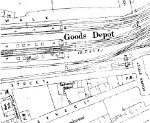 An Act of 1883 authorised the London, Tilbury and
Southend Railway
to build a goods warehouse on Commercial Road, on the site between
Gower's
Walk and Lambeth Street, and to acquire the school site (offering
£11,500 of the £15,000 asking price). The school transferred to cramped
temporary accommodation at 18a Great Alie Street (sufficient only to
house the staff and the printing) while a new school was built two
streets further
west from their old site, on Rupert Street, to
designs by Ernest C. Lee FRIBA (later known as Ernest Claude Ayton-Lee)
- drawing left.
It opened in 1885, and cost £4,230 - though was not as well built as
they hoped, and the trustees went to court over the loss of light
caused by the railway warehouse: Re London, Tilbury
and Southend Ry. and
Gower's Walk Schools (1889)
QBD 326 has often been quoted as precedent in relation to
easements (rights of light), compulsory purchase, and negligence. The
Superintendent (and a qualified printer) in the days before and after the move
was Samuel French Hodsoll; his father had held the post before him.
An Act of 1883 authorised the London, Tilbury and
Southend Railway
to build a goods warehouse on Commercial Road, on the site between
Gower's
Walk and Lambeth Street, and to acquire the school site (offering
£11,500 of the £15,000 asking price). The school transferred to cramped
temporary accommodation at 18a Great Alie Street (sufficient only to
house the staff and the printing) while a new school was built two
streets further
west from their old site, on Rupert Street, to
designs by Ernest C. Lee FRIBA (later known as Ernest Claude Ayton-Lee)
- drawing left.
It opened in 1885, and cost £4,230 - though was not as well built as
they hoped, and the trustees went to court over the loss of light
caused by the railway warehouse: Re London, Tilbury
and Southend Ry. and
Gower's Walk Schools (1889)
QBD 326 has often been quoted as precedent in relation to
easements (rights of light), compulsory purchase, and negligence. The
Superintendent (and a qualified printer) in the days before and after the move
was Samuel French Hodsoll; his father had held the post before him.
Kelly's Directory
of 1897 lists it as a 'Free Industrial, National
[Society] School'; by 1932 (when the printing enterprise had ceased) it
had certainly come fully under the aegis of the NS. Closure was mooted
in the 1930s: the Vicar of St John's wrote in the parish magazine in
1938 No
locality needs more the benefits of this Trust than that in which it
now works, and if the original scheme is regarded by the Educational
Authority as unnecessary and inadequate for obvious reasons that cannot
be dealt with, through lack of means, then alternate schemes, such as an Institute for the educational, physical and spiritual development of boys over school age; and
others that present themselve to such a district, might be considered
and proceeded with. Such an Institute would be in full accord with the
mind of the Founder and we believe his successors, the present
Trustees. Such an [sic] hand-maid to the Church, Whitechapel, and in particular St John's Parish sorely needs. A draft scheme along these lines was published the following year, with funds to pass to the Hackney Free
and Parochial Schools and the premises used for Church of England
Sunday Schools, evening classes and the like. But war intervened, with
heavy bombing in the area during the Blitz, and it continued in
existence until 1952, latterly under the LCC.
It thus took its place as part of the history of industrial, or vocational, schools, and was mentioned as such in the 1926 Hadow Report The Education of the Adolescent. The 1944 Education Act returned to this theme, proposing three kinds of secondary school - grammar, secondary modern and technical - though very few authorities created any schools of the third kind. And the debate on vocational education continues. A creation of its time, Gower's Walk Free (Industrial) School had some contemporary resonances:
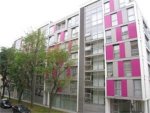
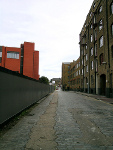

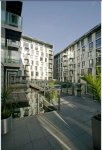 Gower's
Walk is now within the 'City Quarter', on the edges of the current
redevelopment of Goodman's Fields.
Here are some contemporary views:
the second picture shows part of the commercial
buildings on the left due for demolition, and the third picture the
former
warehouses which are now apartments.
Gower's
Walk is now within the 'City Quarter', on the edges of the current
redevelopment of Goodman's Fields.
Here are some contemporary views:
the second picture shows part of the commercial
buildings on the left due for demolition, and the third picture the
former
warehouses which are now apartments.Back to History